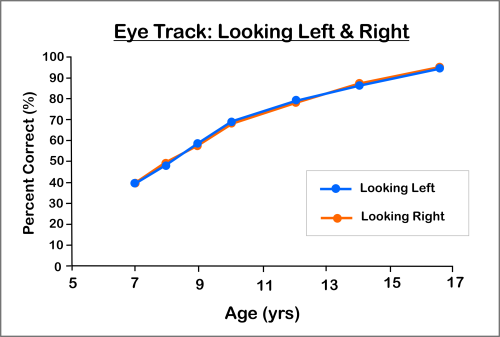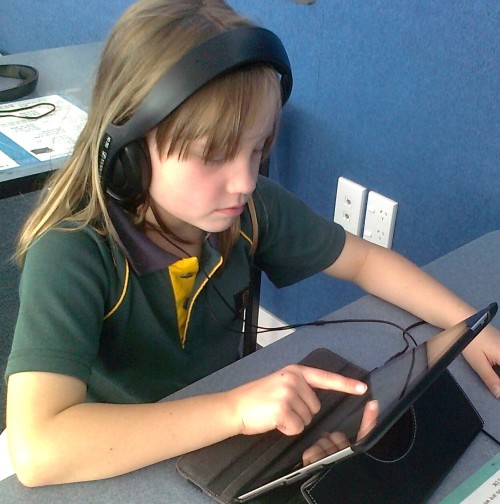Research shows that visual and auditory skills which require rapid processing can take years to reach maturity extending well into the teenage years. Such skills undergo their steepest development during the primary school years but continue to improve throughout secondary school as shown in the graph below.

Because these are also learned skills they may drop below their normal development resulting in specific effects on learning. Like many other brain functions these skills can be improved with training – often to age normal levels. Evidence shows that training visual and auditory skills can improve learning outcomes.
WHAT ARE THE ICEPT TESTS?
The tests used by iCept include tests of eye tracking and visual & auditory perception. The tests are suitable for students ages 7 to 17 years and take about 40 minutes to administer. They are only available on the iPad and are FREE to download. The tests include:
Eye Tracking – tests the rapid eye movements used for reading called “voluntary saccades”. It is not a pure test of eye movements however since this would require using an eye tracking device which is not generally used in clinical practice but it provides a conservative test of voluntary eye saccades (ie. if a problem is found it is likely WORSE when using an eye tracker). A problem with eye tracking can lead to skipping words or lines and can affect reading accuracy and fluency.
Visual Span – tests the window of visual attention to the left and right side of fixation (where we are looking). A reduced visual span leads to fewer letters seen per look. This has been reported in dyslexia along with poor phonological awareness and is associated with slower reading speed.
Visual Count – tests the number of elements that can be seen or counted per look. It is associated with basic arithmetic ability and probably helps with rapidly determining the length of a word.
Visual Spatial – tests how quickly number & letter direction can be assessed. It is frequently associated with poorly developed awareness of ones left and right side and can lead to losing place, poor spacing of letters when writing, and difficulty visualizing words.
Auditory Discrimination – tests a group of skills that require discriminating differences in sounds including volume, gap detection, frequency and temporal order. A problem with this can affect spelling and following instructions.

CAN THESE SKILLS BE TRAINED?
Yes, all of these skills can be improved with training. This is because they are learned skills. Training is directed primarily at the level of the brain rather than the eyes or ears themselves. This is consistent with our current understanding of neuroscience that the brain can be trained. The training offered by iCept is not expensive so that it can be used as a complementary intervention for mild to moderate developmental delays or as the next step following an office-based programme in cases of more significant developmental delays.
View the evidence base for the treatment of problems found on the iCept Testing app.
WHAT DOES TRAINING INVOLVE?
Training involves performing visual and auditory tasks for about 10 minutes a day. This requires a lot of repetition to improve and consolidate these skills. For this reason we recommend doing the skills in the morning and preferably at school using the iPad. Training may extend from a few weeks to 6 months or longer depending on the severity of the problem and the frequency of training. Maintaining the programme takes a significant effort so being able to train during school hours and having the support of the school is invaluable. A picture of an animal at the end of each training session (from a collection of over 650) provides moral support and a “Fast Train” option is available for younger students or those with poor attention.

DOWNLOAD ICEPT
The iCept app can be downloaded from the iPad AppStore by searching under “iCept Testing”. To view the app click on the icon below.
The iCept Testing app is FREE to run and takes about 40 to 45 minutes to complete all of the tests. If training is required this is paid and the cost depends on the number of tasks selected. Referral to an optometrist is advised BEFORE training or at minimum a student should be able to pass the 3 Point Check Test of near vision to demonstrate a stable near visual platform.



